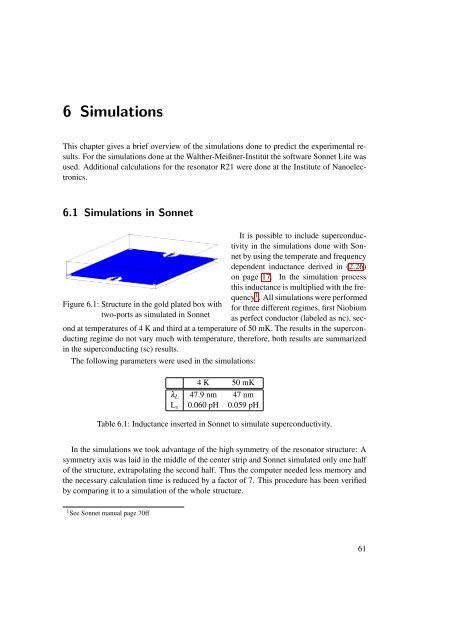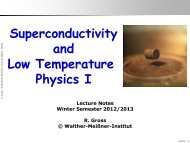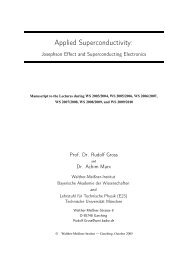Design, Fabrication and Characterization of a Microwave Resonator ...
Design, Fabrication and Characterization of a Microwave Resonator ...
Design, Fabrication and Characterization of a Microwave Resonator ...
Create successful ePaper yourself
Turn your PDF publications into a flip-book with our unique Google optimized e-Paper software.
6 SimulationsThis chapter gives a brief overview <strong>of</strong> the simulations done to predict the experimental results.For the simulations done at the Walther-Meißner-Institut the s<strong>of</strong>tware Sonnet Lite wasused. Additional calculations for the resonator R21 were done at the Institute <strong>of</strong> Nanoelectronics.6.1 Simulations in SonnetFigure 6.1: Structure in the gold plated box withtwo-ports as simulated in SonnetIt is possible to include superconductivityin the simulations done with Sonnetby using the temperate <strong>and</strong> frequencydependent inductance derived in (2.26)on page 17. In the simulation processthis inductance is multiplied with the frequency1 . All simulations were performedfor three different regimes, first Niobiumas perfect conductor (labeled as nc), secondat temperatures <strong>of</strong> 4 K <strong>and</strong> third at a temperature <strong>of</strong> 50 mK. The results in the superconductingregime do not vary much with temperature, therefore, both results are summarizedin the superconducting (sc) results.The following parameters were used in the simulations:4 K 50 mKλ L 47.9 nm 47 nmL s 0.060 pH 0.059 pHTable 6.1: Inductance inserted in Sonnet to simulate superconductivity.In the simulations we took advantage <strong>of</strong> the high symmetry <strong>of</strong> the resonator structure: Asymmetry axis was laid in the middle <strong>of</strong> the center strip <strong>and</strong> Sonnet simulated only one half<strong>of</strong> the structure, extrapolating the second half. Thus the computer needed less memory <strong>and</strong>the necessary calculation time is reduced by a factor <strong>of</strong> 7. This procedure has been verifiedby comparing it to a simulation <strong>of</strong> the whole structure.1 See Sonnet manual page 70ff61
















